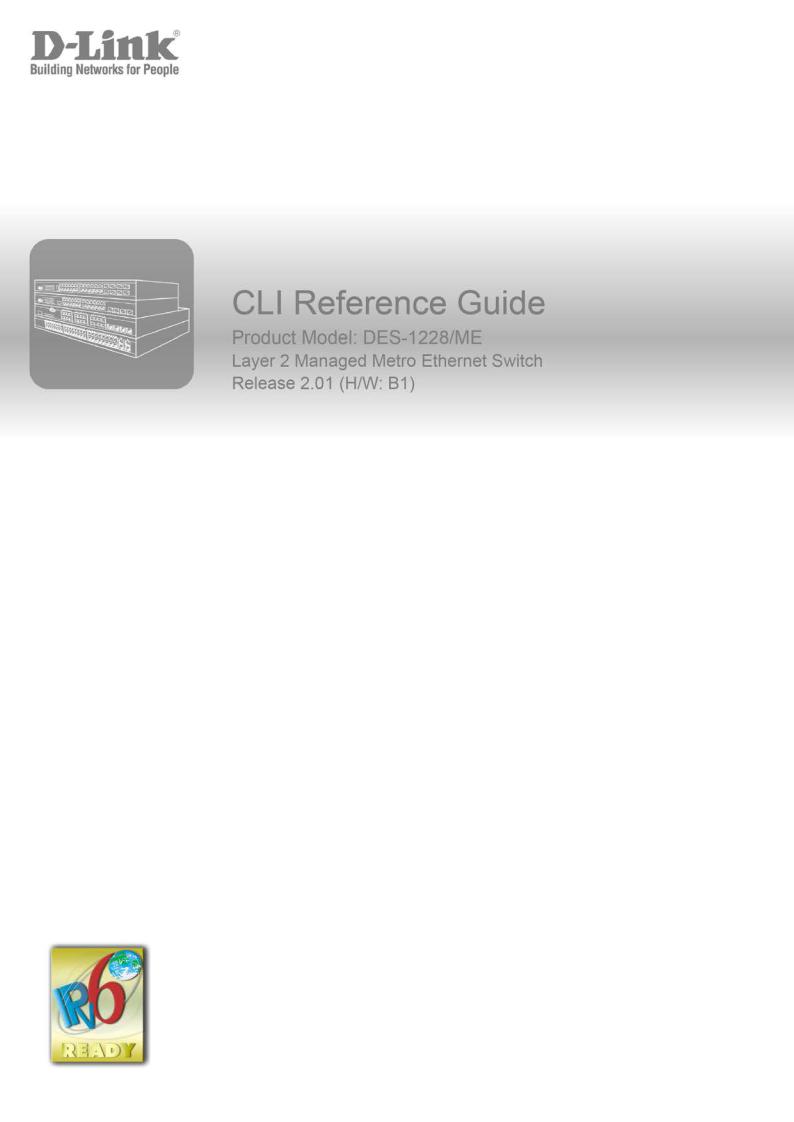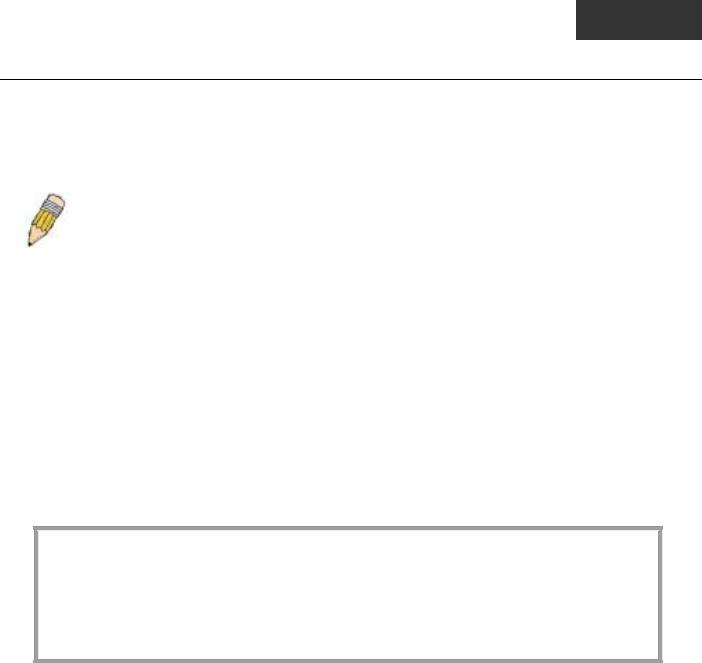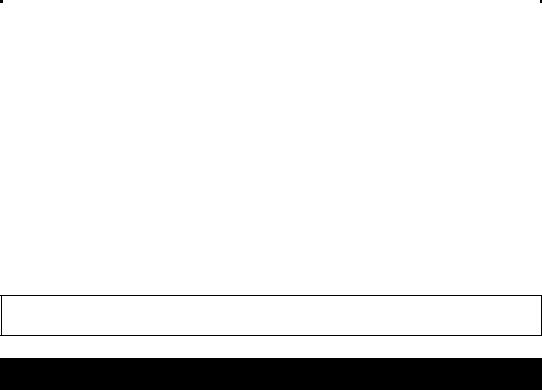D-link DES-1228 User Manual [ru]

DES-1228/ME Metro Ethernet Managed Switch CLI Reference Guide
Information in this document is subject to change without notice. © 2012 D-Link Corporation. All rights reserved.
Reproduction in any manner whatsoever without the written permission of D-Link Corporation is strictly forbidden.
Trademarks used in this text: D-Link and the D-LINK logo are trademarks of D-Link Corporation; Microsoft and Windows are registered trademarks of Microsoft Corporation.
Other trademarks and trade names may be used in this document to refer to either the entities claiming the marks and names or their products. D-Link Corporation disclaims any proprietary interest in trademarks and trade names other than its own.
April 2012 P/N 651ES1228015G
DES-1228/ME Metro Ethernet Managed Switch CLI Reference Guide |
|
TABLE OF CONTENTS |
|
INTRODUCTION ................................................................................................................................................................ |
1 |
USING THE CONSOLE CLI .............................................................................................................................................. |
3 |
COMMAND SYNTAX......................................................................................................................................................... |
7 |
BASIC SWITCH COMMANDS ........................................................................................................................................ |
10 |
MODIFY BANNER AND PROMPT COMMANDS ......................................................................................................... |
34 |
SWITCH PORT COMMANDS ......................................................................................................................................... |
37 |
PORT SECURITY COMMANDS ..................................................................................................................................... |
41 |
NETWORK MANAGEMENT (SNMP) COMMANDS .................................................................................................... |
47 |
SWITCH UTILITY COMMANDS.................................................................................................................................... |
73 |
NETWORK MONITORING COMMANDS ..................................................................................................................... |
88 |
MULTIPLE SPANNING TREE PROTOCOL (MSTP) COMMANDS ......................................................................... |
105 |
FORWARDING DATABASE COMMANDS.................................................................................................................. |
121 |
PACKET STORM CONTROL COMMANDS................................................................................................................ |
129 |
QOS COMMANDS .......................................................................................................................................................... |
133 |
PORT MIRRORING COMMANDS ............................................................................................................................... |
148 |
VLAN COMMANDS........................................................................................................................................................ |
151 |
LINK AGGREGATION COMMANDS .......................................................................................................................... |
160 |
BASIC IP COMMANDS.................................................................................................................................................. |
165 |
IGMP SNOOPING COMMANDS................................................................................................................................... |
172 |
DHCP RELAY COMMANDS ......................................................................................................................................... |
185 |
802.1X COMMANDS ....................................................................................................................................................... |
192 |
ACCESS CONTROL LIST (ACL) COMMANDS .......................................................................................................... |
213 |
CPU FILTERING COMMANDS .................................................................................................................................... |
228 |
SAFEGUARD ENGINE COMMANDS........................................................................................................................... |
230 |
TRAFFIC SEGMENTATION COMMANDS ................................................................................................................. |
233 |
TIME AND SNTP COMMANDS .................................................................................................................................... |
235 |
ARP COMMANDS........................................................................................................................................................... |
241 |
ROUTING TABLE COMMANDS .................................................................................................................................. |
245 |
MAC NOTIFICATION COMMANDS............................................................................................................................ |
249 |
ACCESS AUTHENTICATION CONTROL COMMANDS........................................................................................... |
253 |
SSH COMMANDS ........................................................................................................................................................... |
277 |
SMTP COMMANDS........................................................................................................................................................ |
285 |
CABLE DIAGNOSTICS COMMANDS.......................................................................................................................... |
290 |
DHCP LOCAL RELAY COMMANDS........................................................................................................................... |
292 |
GRATUITOUS ARP COMMANDS ................................................................................................................................ |
296 |
VLAN TRUNKING COMMANDS.................................................................................................................................. |
301 |
DES-1228/ME Metro Ethernet Managed Switch CLI Reference Guide |
|
ASYMMETRIC VLAN COMMANDS............................................................................................................................ |
305 |
IGMP SNOOPING MULTICAST VLAN COMMANDS ............................................................................................... |
307 |
LLDP COMMANDS ........................................................................................................................................................ |
313 |
DOS PREVENTION COMMANDS ................................................................................................................................ |
334 |
IP-MAC-PORT BINDING COMMANDS....................................................................................................................... |
340 |
LOOPBACK DETECTION COMMANDS..................................................................................................................... |
347 |
FLOW METER COMMANDS........................................................................................................................................ |
354 |
ARP SPOOFING PREVENTION COMMANDS............................................................................................................ |
357 |
TECHNICAL SUPPORT COMMANDS......................................................................................................................... |
360 |
COMMAND HISTORY COMMANDS........................................................................................................................... |
363 |
BPDU ATTACK PROTECTION COMMANDS ............................................................................................................ |
367 |
PPPOE CIRCUIT ID INSERTION COMMANDS ......................................................................................................... |
374 |
DHCP SERVER SCREENING SETTINGS .................................................................................................................... |
377 |
IPV6 NEIGHBOUR DISCOVERY COMMANDS.......................................................................................................... |
380 |
DEBUG SOFTWARE COMMANDS .............................................................................................................................. |
384 |
BPDU TUNNEL COMMANDS ....................................................................................................................................... |
395 |
APPENDIX A – PASSWORD RECOVERY PROCEDURE .......................................................................................... |
398 |
APPENDIX B – SYSTEM LOG ENTRIES ..................................................................................................................... |
399 |
APPENDIX C – TRAP ENTRIES ................................................................................................................................... |
406 |
APPENDIX D - RADIUS ATTRIBUTES ASSIGNMENT.............................................................................................. |
408 |

DES-1228/ME Metro Ethernet Managed Switch CLI Reference Guide
1
INTRODUCTION
The Switch can be managed through the Switch’s serial port, Telnet, or the Web-based management agent. The Command Line Interface (CLI) can be used to configure and manage the Switch via the serial port or Telnet interfaces.
This manual provides a reference for all of the commands contained in the CLI. Configuration and management of the Switch via the Web-based management agent is discussed in the Manual. Configuration and management of the Switch via the Web-based management agent is discussed in the User’s Guide.
Accessing the Switch via the Serial Port
The Switch’s serial port’s default settings are as follows:
•9600 baud
•no parity
•8 data bits
•1 stop bit
A computer running a terminal emulation program capable of emulating a VT-100 terminal and a serial port configured as above are then connected to the Switch’s serial port via an RJ-45 console cable.
With the serial port properly connected to a management computer, the following screen should be visible. If this screen does not appear, try pressing Ctrl+R to refresh the console screen.
DES-1228/ME Metro Ethernet Switch
Command Line Interface
Firmware: Build 2.01.001
Copyright(C) 2012 D-Link Corporation. All rights reserved.
UserName:
PassWord:
Figure 1 - 1. Initial CLI screen
There is no initial username or password. Just press the Enter key twice to display the CLI input cursor − DES-1228/ME:5#. This is the command line where all commands are input.
Setting the Switch’s IP Address
Each Switch must be assigned its own IP Address, which is used for communication with an SNMP network manager or other TCP/IP application (for example BOOTP, TFTP). The Switch’s default IP address is 10.90.90.90. Users can change the default Switch IP address to meet the specification of your networking address scheme.
The Switch is also assigned a unique MAC address by the factory. This MAC address cannot be changed, and can be found on the initial boot console screen – shown below.
Boot Procedure |
V2.00.001 |
-------------------------------------------------------------------------------
Power On Self |
Test ........................................ |
100% |
||
MAC |
Address |
: |
00-12-28-8E-77-00 |
|
H/W |
Version |
: |
B1 |
100% |
Please wait, loading V2.01.001 Runtime image .............. |
||||
Figure 1 - 2. Boot screen
The Switch’s MAC address can also be found in the Web management program on the Switch Information (Basic Settings) window in the Configuration folder.
The IP address for the Switch must be set before it can be managed with the Web-based manager. The Switch IP address can be automatically set using BOOTP or DHCP protocols, in which case the actual address assigned to the Switch must be known.
The IP address may be set using the Command Line Interface (CLI) over the console serial port as follows:
1

DES-1228/ME Metro Ethernet Managed Switch CLI Reference Guide
Starting at the command line prompt, enter the command config ipif System ipaddress xxx.xxx.xxx.xxx/yyy.yyy.yyy.yyy. Where the x’s represent the IP address to be assigned to the IP interface named System and the y’s represent the corresponding subnet mask.
Alternatively, users can enter config ipif System ipaddress xxx.xxx.xxx.xxx/z. Where the x’s represent the IP address to be assigned to the IP interface named System and the z represents the corresponding number of subnets in CIDR notation.
The IP interface named System on the Switch can be assigned an IP address and subnet mask which can then be used to connect a management station to the Switch’s Telnet or Web-based management agent.
DES-1228/ME:5#config ipif System ipaddress 10.73.21.11/8
Command: config ipif System ipaddress 10.73.21.11/8
Success.
DES-1228/ME:5#
Figure 1 - 3. Assigning an IP Address
In the above example, the Switch was assigned an IP address of 10.73.21.11 with a subnet mask of 255.0.0.0. The system message Success indicates that the command was executed successfully. The Switch can now be configured and managed via Telnet, SNMP MIB browser and the CLI or via the Web-based management agent using the above IP address to connect to the Switch.
2

DES-1228/ME Metro Ethernet Managed Switch CLI Reference Guide
2
USING THE CONSOLE CLI
The Switch supports a console management interface that allows the user to connect to the Switch’s management agent via a serial port and a terminal or a computer running a terminal emulation program. The console can also be used over the network using the TCP/IP Telnet protocol. The console program can be used to configure the Switch to use an SNMP-based network management application over the network.
This chapter describes how to use the console interface to access the Switch, change its settings, and monitor its operation.
Note: Switch configuration settings are saved to non-volatile RAM using the save command. The current configuration will then be retained in the Switch’s NV-RAM, and reloaded when the Switch is rebooted. If the Switch is rebooted without using the save command, the last configuration saved to NV-RAM will be loaded.
Connecting to the Switch
The console interface is used by connecting the Switch to a VT100-compatible terminal or a computer running an ordinary terminal emulator program (e.g., the HyperTerminal program included with the Windows operating system) using an RJ-45 console cable. Your terminal parameters will need to be set to:
•VT-100 compatible
•9600 baud
•8 data bits
•No parity
•One stop bit
•No flow control
Users can also access the same functions over a Telnet interface. Once users have set an IP address for your Switch, users can use a Telnet program (in VT-100 compatible terminal mode) to access and control the Switch. All of the screens are identical, whether accessed from the console port or from a Telnet interface.
After the Switch reboots and users have logged in, the console looks like this:
DES-1228/ME Metro Ethernet Switch
Command Line Interface
Firmware: Build 2.01.001
Copyright(C) 2012 D-Link Corporation. All rights reserved.
UserName:
PassWord:
Figure 2 - 1. Initial Console Screen after logging in
Commands are entered at the command prompt, DES-1228/ME:5#.
There are a number of helpful features included in the CLI. Entering the ? command will display a list of all of the top-level commands.
3

DES-1228/ME Metro Ethernet Managed Switch CLI Reference Guide
..
?
cable_diag ports clear
clear arptable clear counters
clear dos_prevention counters clear fdb
clear flood_fdb
clear igmp_snooping data_driven_group clear log
clear port_security_entry port config 802.1p default_priority config 802.1p user_priority config 802.1x auth_mode
config 802.1x auth_parameter ports config 802.1x auth_protocol
config 802.1x capability ports config 802.1x guest_vlan ports config 802.1x init
config 802.1x reauth
config access_profile profile_id
CTRL+C ESC q Quit SPACE n Next Page ENTER Next Entry a All
Figure 2 - 2. The ? Command
When users enter a command without its required parameters, the CLI will prompt users with Next possible completions: message.
DES-1228/ME:5#config account
Command: config account
Next possible completions: <username>
DES-1228/ME:5#
Figure 2 - 3. Example Command Parameter Help
In this case, the command config account was entered without the parameter <username>. The CLI will then prompt users to enter the <username> with the message, Next possible completions:. Every command in the CLI has this feature, and complex commands have several layers of parameter prompting.
In addition, after typing any given command plus one space, users can see all of the next possible sub-commands, in sequential order, by repeatedly pressing the Tab key.
To re-enter the previous command at the command prompt, press the up arrow cursor key. The previous command will appear at the command prompt.
4

DES-1228/ME Metro Ethernet Managed Switch CLI Reference Guide
DES-1228/ME:5#config account
Command: config account
Next possible completions: <username>
DES-1228/ME:5#config account
Command: config account
Next possible completions: <username>
DES-1228/ME:5#
Figure 2 - 4. Using the Up Arrow to Re-enter a Command
In the above example, the command config account was entered without the required parameter <username>, the CLI returned the Next possible completions: <username> prompt. The up arrow cursor control key was pressed to re-enter the previous command (config account) at the command prompt. Now the appropriate username can be entered and the config account command reexecuted.
All commands in the CLI function in this way. In addition, the syntax of the help prompts are the same as presented in this manual
− angle brackets < > indicate a numerical value or character string, braces { } indicate optional parameters or a choice of parameters, and brackets [ ] indicate required parameters.
If a command is entered that is unrecognized by the CLI, the top-level commands will be displayed under the Available commands: prompt.
|
DES-1228/ME:5#the |
|
|
|
|
Available commands: |
? |
cable_diag |
clear |
|
.. |
|||
|
config |
create |
delete |
dir |
|
disable |
download |
enable |
login |
|
logout |
ping |
reboot |
reset |
|
save |
show |
smtp |
telnet |
|
traceroute |
upload |
|
|
|
DES-1228/ME:5# |
|
|
|
|
|
|
|
|
Figure 2 - 5. The Next Available Commands Prompt
The top-level commands consist of commands such as show or config. Most of these commands require one or more parameters to narrow the top-level command. This is equivalent to show what? or config what? Where the what? is the next parameter.
For example, if users enter the show command with no additional parameters, the CLI will then display all of the possible next parameters.
5

DES-1228/ME Metro Ethernet Managed Switch CLI Reference Guide
DES-1228/ME:5#show
Command: show |
|
|
|
Next possible completions: |
access_profile |
account |
|
802.1p |
802.1x |
||
acct_client |
address_binding |
arp_spoofing_prevention |
|
arpentry |
asymmetric_vlan |
auth_client |
auth_diagnostics |
auth_session_statistics |
auth_statistics |
authen |
|
authen_enable |
authen_login |
authen_policy |
auto_fdb |
autoconfig |
bandwidth_control |
bpdu_protection |
bpdu_tunnel |
command |
command_history |
config |
cos |
cpu_access_profile |
dos_prevention |
cpu_filter |
dhcp_local_relay |
dhcp_relay |
dscp_mapping |
error |
|
fdb |
filter |
firmware |
flood_fdb |
flow_meter |
gratuitous_arp |
greeting_message |
gvrp |
igmp |
igmp_snooping |
ipif |
iproute |
jumbo_frame |
lacp_ports |
link_aggregation |
lldp |
log |
log_save_timing |
loopdetect |
mac_notification |
mirror |
multicast |
multicast_fdb |
packet |
per_queue |
port_security |
ports |
pppoe |
pvid |
radius |
router_ports |
safeguard_engine |
scheduling |
scheduling_mechanism |
snmp |
serial_port |
session |
smtp |
sntp |
|
ssh |
stp |
switch |
syslog |
tech_support |
terminal_line |
time |
traffic |
traffic_segmentation |
vlan_trunk |
trusted_host |
utilization |
vlan |
|
|
|
DES-1228/ME:5#
Figure 2 - 6. Next possible completions: Show Command
In the above example, all of the possible next parameters for the show command are displayed. At the next command prompt, the up arrow was used to re-enter the show command, followed by the account parameter. The CLI then displays the user accounts configured on the Switch.
6

DES-1228/ME Metro Ethernet Managed Switch CLI Reference Guide
3
COMMAND SYNTAX
The following symbols are used to describe how command entries are made and values and arguments are specified in this manual.
Note: All commands are case-sensitive. Be sure to disable Caps Lock or any other unwanted function that changes text case.
<angle brackets>
Purpose |
Encloses a variable or value that must be specified. |
|
|
Syntax |
config ipif <System> [{ipaddress <network_address> | vlan <vlan_name |
|
32> | state [enable | disable}] | bootp | dhcp] |
Description |
In the above syntax example, users must supply an IP interface name in the |
|
<System> space, a VLAN name in the <vlan_name 32> space, and the |
|
network address in the <network_address> space. Do not type the angle |
|
brackets. |
|
|
Example Command |
config ipif System ipaddress 10.24.22.5/8 vlan Design state enable |
|
|
[square brackets]
Purpose |
Encloses a required value or set of required arguments. One value or |
|
argument can be specified. |
|
|
Syntax |
create account [admin | operator| Power User|user] <username 15> |
|
|
Description |
In the above syntax example, users must specify either an admin or a user |
|
level account to be created. Do not type the square brackets. |
Example Command |
create account admin ctsnow |
|
|
| vertical bar
Purpose |
Separates two or more mutually exclusive items in a list, one of which must |
|
be entered. |
|
|
Syntax |
create account [admin | operator| Power User|user] <username 15> |
|
|
Description |
In the above syntax example, users must specify either admin, or user. Do |
|
not type the vertical bar. |
Example Command |
create account admin ctsnow |
|
|
7
DES-1228/ME Metro Ethernet Managed Switch CLI Reference Guide |
||
|
|
|
{braces} |
|
|
Purpose |
|
Encloses an optional value or set of optional arguments. |
|
|
|
Syntax |
|
reset {[config | system]} {force_agree} |
|
|
|
Description |
|
In the first part of the above syntax example, users have the option to |
|
|
specify config or system. It is not necessary to specify either optional value, |
|
|
however the effect of the system reset is dependent on which, if any, value |
|
|
is specified. Therefore, with this example there are three possible outcomes |
|
|
of performing a system reset. Do not type the braces. |
|
|
|
Example command |
|
reset config |
|
|
|
|
|
|
(parentheses) |
|
|
Purpose |
Indicates at least one or more of the values or arguments in the preceding |
|
|
syntax enclosed by braces must be specified. |
|
Syntax |
config dhcp_relay {hops <value 1-16> | time <sec 0-65535>}(1) |
|
|
|
|
Description |
In the above syntax example, users have the option to specify hops or time or |
|
|
both of them. The "(1)" following the set of braces indicates at least one |
|
|
argument or value within the braces must be specified. Do not type the |
|
|
parentheses. |
|
|
|
|
Example |
config dhcp_relay hops 3 |
|
command |
|
|
|
|
|
Line Editing Key Usage |
||
Delete |
|
Deletes the character under the cursor and then shifts the remaining |
|
|
characters in the line to the left. |
|
|
|
Backspace |
|
Deletes the character to the left of the cursor and then shifts the remaining |
|
|
characters in the line to the left. |
|
|
|
Insert or Ctrl+R |
|
Toggle on and off. When toggled on, inserts text and shifts previous text to |
|
|
the right. |
Left Arrow |
|
Moves the cursor to the left. |
|
|
|
Right Arrow |
|
Moves the cursor to the right. |
|
|
|
Up Arrow |
|
Repeats the previously entered command. Each time the up arrow is |
|
|
pressed, the command previous to that displayed appears. This way it is |
|
|
possible to review the command history for the current session. Use the |
|
|
down arrow to progress sequentially forward through the command history |
|
|
list. |
|
|
|
Down Arrow |
|
The down arrow will display the next command in the command history |
|
|
entered in the current session. This displays each command sequentially as |
|
|
it was entered. Use the up arrow to review previous commands. |
|
|
|
Tab |
|
Shifts the cursor to the next field to the left. |
|
|
|
8
|
DES-1228/ME Metro Ethernet Managed Switch CLI Reference Guide |
|
|
|
|
Multiple Page Display Control Keys |
||
Space |
|
Displays the next page. |
|
|
|
CTRL+c |
|
Stops the display of remaining pages when multiple pages are to be |
|
|
displayed. |
|
|
|
ESC |
|
Stops the display of remaining pages when multiple pages are to be |
|
|
displayed. |
|
|
|
n |
|
Displays the next page. |
|
|
|
p |
|
Displays the previous page. |
|
|
|
q |
|
Stops the display of remaining pages when multiple pages are to be |
|
|
displayed. |
|
|
|
r |
|
Refreshes the pages currently displayed. |
|
|
|
a |
|
Displays the remaining pages without pausing between pages. |
|
|
|
Enter |
|
Displays the next line or table entry. |
|
|
|
9

DES-1228/ME Metro Ethernet Managed Switch CLI Reference Guide
4
BASIC SWITCH COMMANDS
The Basic Switch commands in the Command Line Interface (CLI) are listed (along with the appropriate parameters) in the following table:
Command |
Parameters |
|
|
enable password encryption |
|
|
|
disable password encryption |
|
|
|
create account |
[admin|operator|Power User|user] <username 15> |
|
|
config account |
<username> {encrypt [plain_text|sha_1] <password>} |
|
|
show account |
|
|
|
delete account |
<username> |
|
|
show session |
|
|
|
show switch |
|
|
|
show serial_port |
|
|
|
config serial_port |
{baud_rate [9600 | 19200 | 38400 | 115200] | auto_logout [never | 2_minutes | |
|
5_minutes | 10_minutes | 15_minutes]} (1) |
enable clipaging |
|
|
|
disable clipaging |
|
|
|
enable telnet |
{<tcp_port_number 1-65535>} |
|
|
disable telnet |
|
|
|
telnet |
<ipaddr> {tcp_port <value 0-65535>} |
|
|
ping |
[<ipaddr> | <domain_name 255>] {times <value 1-255> | timeout <sec 1-99> | |
|
source_ip <ipaddr>} |
|
|
enable web |
{<tcp_port_number 1-65535>} |
|
|
disable web |
|
|
|
save |
{ [config {config_id <value 1-2>} | log | all]} |
|
|
reboot |
{force_agree} |
|
|
reset |
{[config | system ]} { force_agree} |
|
|
login |
|
|
|
logout |
|
|
|
show config |
[ current_config | config_in_nvram <config_id 1-2> ] {[include | exclude | begin] |
|
<filter_string 80> {<filter_string 80> {<filter_string 80>}} {[include | exclude | |
|
begin] <filter_string 80> {<filter_string 80> {<filter_string 80>}} |
|
{[include | exclude | begin] <filter_string 80> {<filter_string 80> {<filter_string |
|
80>}}}}} |
config terminal_line |
[default | <value 20-80>] |
|
|
show terminal_line |
|
|
|
enable jumbo_frame |
|
|
|
disable jumbo_frame |
|
|
|
10

DES-1228/ME Metro Ethernet Managed Switch CLI Reference Guide
Command |
Parameters |
show jumbo_frame |
|
|
|
clear |
|
|
|
config configuration config_id |
|
|
|
config configuration trap |
{ save [ enable | disable ] | upload [ enable | disable ] | download [ enable | |
|
disable ] }(1) |
|
|
show config information |
|
|
|
Each command is listed, in detail, in the following sections:
enable password encryption
Purpose |
Used to enable password encryption on a user account. |
Syntax |
enable password encryption |
Description |
The user account configuration information will be stored in the |
|
configuration file, and can be applied to the system at a time in the |
|
future. If the password encryption is enabled, the password will be in |
|
encrypted form. If password encryption is disabled and the user |
|
specifies the password in encrypted form, or if the password has |
|
been converted to encrypted form by the last enabled password |
|
encryption command, the password will still be in encrypted form. It |
|
can not revert back to plain text. |
Parameters |
None. |
Restrictions |
Only Administrator level users can issue this command. |
Example usage:
To enable password encryption on the Switch.
DES-1228/ME:5#enable password encryption
Command: enable password encryption
Success.
DES-1228/ME:5#
disable password encryption
Purpose |
Used to disable password encryption on a user account. |
Syntax |
disable password encryption |
Description |
The user account configuration information will be stored in the |
|
configuration file, and can be applied to the system at a time in the |
|
future. If the password encryption is enabled, the password will be in |
|
encrypted form. If password encryption is disabled and the user |
|
specifies the password in encrypted form, or if the password has |
|
been converted to encrypted form by the last enabled password |
|
encryption command, the password will still be in encrypted form. It |
|
can not revert back to plain text. |
Parameters |
None. |
Restrictions |
Only Administrator level users can issue this command. |
Example usage:
To disable password encryption on the Switch.
11

DES-1228/ME Metro Ethernet Managed Switch CLI Reference Guide
DES-1228/ME:5#disable password encryption
Command: disable password encryption
Success.
DES-1228/ME:5#
12

|
DES-1228/ME Metro Ethernet Managed Switch CLI Reference Guide |
|
|
create account |
|
Purpose |
Used to create user accounts. |
Syntax |
create [admin|operator|Power User|user] <username 15> |
Description |
This command is used to create user accounts that consist of a |
|
username of 1 to 15 characters and a password of 0 to 15 |
|
characters. Up to eight user accounts can be created. |
Parameters |
admin <username> – Name of the administrator account. |
|
operator <username>- Specify an operator level account. |
|
Power User <username> - Specify a power user level account, The |
|
power user level is lower than the operator level and higher than the |
|
user level. |
|
user <username> – Name of the user account. |
|
username - The user name, with a minimum of 1 character and a |
|
maximum of 15 characters |
Restrictions |
Only Administrator level users can issue this command. |
|
Usernames can be between 1 and 15 characters. |
|
Passwords can be between 0 and 15 characters. |
|
|
Example usage:
To create an operator-level user account with the username “dlink”.
DES-1228/ME:5#create account operator dlink
Command: create account operator dlink
Enter a case-sensitive new password:*****
Enter the new password again for confirmation:*****
Success.
DES-1228/ME:5#
NOTICE: In the case of lost passwords or password corruption, please refer to Appendix C Password Recovery Procedure, at the end of this manual which will guide you through the steps necessary to resolve this issue.
13

|
DES-1228/ME Metro Ethernet Managed Switch CLI Reference Guide |
|
|
config account |
|
Purpose |
Used to configure user accounts. |
Syntax |
config account <username> {encrypt [plain_text|sha_1] <password>} |
Description |
This command is used to configure a user account that has been created using the |
|
create account command. When the password information is not specified in the |
|
command, the system will prompt the user to input the password interactively. For |
|
this case, the user can only input the plain text password. |
|
If the password is present in the command, the user can select to input the |
|
password in the plain text form or in the encrypted form. The encryption algorithm is |
|
based on SHA-1. |
Parameters |
<username> – The name of the account. The account must already be defined. |
|
plain_text – Select to specify the password in plain text form. |
|
sha_1 – Select to specify the password in the SHA-1 encrypted form. |
|
password – The password for the usefr account. The length of the password in plain |
|
text form and in encrypted form are different. For the plain text form, passwords must |
|
have a minimum of 0 character and can have a maximum of 15 characters. For the |
|
encrypted form password, the length is fixed to 35 bytes long. The password is case- |
|
sensitive. |
Restrictions |
Only Administrator level users can issue this command. |
|
Usernames can be between 1 and 15 characters. |
|
Passwords can be between 0 and 15 characters. |
|
|
Example usage:
To configure the user password of “dlink” account:
DES-1228/ME:5#config account dlink
Command: config account dlink
Enter a old password:****
Enter a case-sensitive new password:*****
Enter the new password again for confirmation:*****
Success.
DES-1228/ME:5#
14

DES-1228/ME Metro Ethernet Managed Switch CLI Reference Guide |
|
|
|
show account |
|
Purpose |
Used to display user accounts. |
Syntax |
show account |
Description |
This command is used to display all user accounts created on the |
|
Switch. Up to eight user accounts can exist at one time. |
Parameters |
None. |
Restrictions |
Only Administrator level users can issue this command. |
|
|
Example usage:
To display the accounts that have been created:
DES-1228/ME:5#show account
Command: show account
Current Accounts: |
Access |
Level |
Username |
||
------------------ |
------------ |
|
admin |
Admin |
|
dlink |
Operator |
|
beta |
Power |
User |
guest |
User |
|
Total Entries : 4
DES-1228/ME:5#
delete account
Purpose |
Used to delete an existing user account. |
Syntax |
delete account <username> |
Description |
This command is used to delete a user account that has been |
|
created using the create account command. |
Parameters |
<username> – The name of the account to be deleted. |
Restrictions |
Only Administrator level users can issue this command. |
Example usage:
To delete the user account “dlink”:
DES-1228/ME:5#delete account dlink
Command: delete account dlink
Success.
DES-1228/ME:5#
15

DES-1228/ME Metro Ethernet Managed Switch CLI Reference Guide
show session
|
|
|
Purpose |
Used to display a list of currently logged-in users. |
|
||
|
|
|
Syntax |
show session |
|
|
|
|
|
|
Description |
This command is used to display a list of all the users that are |
|
||
|
|
|
|
logged-in at the time the command is issued. |
|
|
|
|
|
|
Parameters |
None. |
|
|
|
|
|
|
Restrictions |
None. |
|
|
|
|
|
|
|
|
|
|
|
Example usage: |
|
|
|
|
|||
To display the way that the users logged in: |
|
|
|
||||
|
|
|
|
|
|||
|
DES-1228/ME:5#show session |
|
|
|
|||
|
Command: show session |
|
|
|
|||
|
ID |
|
Live Time |
From |
Level |
Name |
|
|
-- |
------------ |
--------------------------------------- ----- |
--------------- |
|
||
|
8 |
0:2:27.60 |
Serial Port |
5 |
dlink |
|
|
|
Total Entries: 1 |
|
|
|
|
||
|
CTRL+C ESC q Quit SPACE n Next Page p Previous Page r Refresh |
|
|
||||
16

DES-1228/ME Metro Ethernet Managed Switch CLI Reference Guide
show switch
Purpose |
Used to display general information about the Switch. |
Syntax |
show switch |
Description |
This command is used to display information about the Switch. |
Parameters |
None. |
Restrictions |
None. |
Example usage:
To display the Switch’s information:
DES-1228/ME:5#show |
switch |
|
Command: show switch |
|
|
Device Type |
: DES-1228/ME Metro Ethernet Switch |
|
MAC Address |
: |
00-12-28-8E-77-00 |
IP Address |
: |
10.90.90.90 (Manual) |
VLAN Name |
: |
default |
Subnet Mask |
: |
255.0.0.0 |
Default Gateway |
: |
0.0.0.0 |
Boot PROM Version |
: |
Build 2.00.001 |
Firmware Version |
: |
Build 2.01.001 |
Hardware Version |
: |
B1 |
System Name |
: |
|
System Location |
: |
0 days, 1 hours, 46 minutes, 17 seconds |
System Uptime |
: |
|
System Contact |
: |
|
Spanning Tree |
: Disabled |
|
GVRP |
: Disabled |
|
IGMP Snooping |
: Disabled |
|
VLAN Trunk |
: Disabled |
|
802.1X |
: Disabled |
|
Telnet |
: Enabled (TCP 23) |
|
Web |
: Enabled (TCP 80) |
|
RMON |
: Disabled |
|
SSH |
: Disabled |
|
CLI Paging |
: Enabled |
|
Syslog Global State: Disabled |
||
Dual Image |
: Supported |
|
Password Encryption Status : Disabled
DES-1228/ME:5#
17

|
|
DES-1228/ME Metro Ethernet Managed Switch CLI Reference Guide |
|
|
|
|
|
|
show serial_port |
|
|
|
Purpose |
Used to display the current serial port settings. |
|
|
Syntax |
show serial_port |
|
|
Description |
This command is used to display the current serial port settings. |
|
|
Parameters |
None. |
|
Restrictions None
Example usage:
To display the serial port setting:
DES-1228/ME:5#show serial_port
Command: show serial_port
Baud Rate |
: 9600 |
||
Data |
Bits |
: 8 |
|
Parity Bits |
: None |
||
Stop |
Bits |
: |
1 |
Auto-Logout |
: |
10 mins |
|
DES-1228/ME:5#
18

DES-1228/ME Metro Ethernet Managed Switch CLI Reference Guide
config serial_port
Purpose Used to configure the serial port.
Syntax config serial_port { baud_rate [9600 | 19200 | 38400 | 115200] | auto_logout [never | 2_minutes | 5_minutes | 10_minutes | 15_minutes] } (1)
Description This command is used to configure the serial port’s baud rate and auto logout settings.
Parameters baud_rate [9600 | 19200 | 38400 | 115200] − The serial bit rate that will be used to communicate with the management host. There are four options: 9600, 19200, 38400, and 115200.
never − No time limit on the length of time the console can be open with no user input.
2_minutes − The console will log out the current user if there is no user input for 2 minutes.
5_minutes − The console will log out the current user if there is no user input for 5 minutes.
10_minutes − The console will log out the current user if there is no user input for 10 minutes.
15_minutes − The console will log out the current user if there is no user input for 15 minutes.
Restriction Only Administrator level and Operator level users can issue this command. s
Example usage:
To configure the baud rate:
DES-1228/ME:5#config serial_port baud_rate 115200
Command: config serial_port baud_rate 115200
Success.
DES-1228/ME:5#
19

|
DES-1228/ME Metro Ethernet Managed Switch CLI Reference Guide |
|
|
enable clipaging |
|
Purpose |
Used to pause the scrolling of the console screen when a command |
|
displays more than one page. |
Syntax |
enable clipaging |
Description |
This command is used when issuing a command which causes the |
|
console screen to rapidly scroll through several pages. This |
|
command will cause the console to pause at the end of each page. |
|
The default setting is enabled. |
Parameters |
None. |
Restrictions |
Only Administrator level users, Operator level and Power User level |
|
users can issue this command. |
Example usage:
To enable pausing of the screen display when the show command output reaches the end of the page:
DES-1228/ME:5#enable clipaging
Command: enable clipaging
Success.
DES-1228/ME:5#
disable clipaging
Purpose |
Used to disable the pausing of the console screen scrolling at the |
|
end of each page when a command displays more than one screen |
|
of information. |
Syntax |
disable clipaging |
Description |
This command is used to disable the pausing of the console screen |
|
at the end of each page when a command would display more than |
|
one screen of information. |
Parameters |
None. |
Restrictions |
Only Administrator level users, Operator level and Power User level |
|
users can issue this command. |
Example usage:
To disable pausing of the screen display when show command output reaches the end of the page:
DES-1228/ME:5#disable clipaging
Command: disable clipaging
Success.
DES-1228/ME:5#
20

DES-1228/ME Metro Ethernet Managed Switch CLI Reference Guide |
|
|
|
enable telnet |
|
Purpose |
Used to enable communication with and management of the Switch |
|
using the Telnet protocol. |
Syntax |
enable telnet {<tcp_port_number 1-65535>} |
Description |
This command is used to enable the Telnet protocol on the Switch. |
|
The user can specify the TCP port number the Switch will use to |
|
listen for Telnet requests. |
Parameters |
<tcp_port_number 1-65535> − The TCP port number. TCP ports |
|
are numbered between 1 and 65535. The “well-known” TCP port for |
|
the Telnet protocol is 23. |
Restrictions |
Only Administrator level and Operator level users can issue this |
|
command. |
Example usage:
To enable Telnet and configure port number:
ES-1228/ME:5#enable telnet
Command: enable telnet
Success.
DES-1228/ME:5#
disable telnet
Purpose |
Used to disable the Telnet protocol on the Switch. |
Syntax |
disable telnet |
Description |
This command is used to disable the Telnet protocol on the Switch. |
Parameters |
None. |
Restrictions |
Only Administrator level and Operator level users can issue this |
|
command. |
|
|
Example usage:
To disable the Telnet protocol on the Switch:
DES-1228/ME:5#disable telnet
Command: disable telnet
Success.
DES-1228/ME:5#
21

DES-1228/ME Metro Ethernet Managed Switch CLI Reference Guide |
|
|
|
telnet |
|
Purpose |
Used to Telnet another device on the network. |
Syntax |
telnet <ipaddr> {tcp_port <value 0-65535>} |
Description |
This command is used to connect to another device’s management |
|
through Telnet. |
Parameters |
<ipaddr> − Enter the IP address of the device to connect through, |
|
using Telnet. |
|
tcp_port <value 0-65535> − Enter the TCP port number used to |
|
connect through. The common TCP port number for telnet is 23. |
Restrictions |
Only Administrator level, Operator level and Power User level users |
|
can issue this command. |
|
|
Example usage:
To connect to a device through telnet with an IP address of 10.53.13.99:
DES-1228/ME:5#telnet 10.53.13.99 tcp_port 23
Command: telnet 10.53.13.99 tcp_port 23
ping
Purpose |
Used to ping a remote IP address on the network. |
Syntax |
ping [<ipaddr> | <domain_name 255>] {times <value 1-255> | |
|
timeout <sec 1-99> | source_ip <ipaddr>} |
Description |
This command is used to send Internet Control Message Protocol |
|
(ICMP) echo messages to a remote IP address. The remote IP |
|
address will then “echo” or return the message. This is used to |
|
confirm connectivity between the switch and the remote device. |
Parameters |
<ipaddr> − Specifies the IP address of the host. |
|
<domain_name 255> - Specifies the domain name of the host. This |
|
name can be up to 255 characters long. |
|
times - (Optional) Specify the number of individual ICMP echo |
|
messages to be sent. |
|
value 1-255 - Specify the number of individual ICMP echo |
|
messages to be sent. A value of 0 will send an infinite ICMP echo |
|
messages. The maximum value is 255. The default is 0. |
|
timeout – Specify the timeout period while waiting for a response |
|
from the remote device. A value of 1 to 99 seconds can be |
|
specified. The default is 1 second. |
|
<sec 1-99> - Specify the time-out period while waiting for a |
|
response from the remote device. A value of 1 to 99 seconds can |
|
be specified. The default is 1 second. |
|
source_ip - Specifies the source IP address of the ping packets. If |
|
specified, the IP address will be used as the packets’ source IP |
|
address that ping send to remote host. |
|
<ipaddr> - Enter the source IP address used here. |
Restrictions |
None. |
|
|
22

DES-1228/ME Metro Ethernet Managed Switch CLI Reference Guide
To send ICMP echo message to “10.51.17.1” for 4 times:
DES-1228/ME:5#ping 10.51.17.1 times 4
Command: ping 10.51.17.1 times 4
Reply from 10.51.17.1, time<10ms
Reply from 10.51.17.1, time<10ms
Reply from 10.51.17.1, time<10ms
Reply from 10.51.17.1, time<10ms
Ping Statistics for 10.51.17.1
Packets: Sent =4, Received =4, Lost =0
DES-1228/ME:5#
enable web
Purpose |
Used to enable the HTTP-based management software on the |
|
Switch. |
Syntax |
enable web {<tcp_port_number 1-65535>} |
Description |
This command is used to enable the Web-based management |
|
software on the Switch. The user can specify the TCP port number |
|
the Switch will use to listen for Telnet requests. |
Parameters |
<tcp_port_number 1-65535> − The TCP port number. TCP ports are |
|
numbered between 1 and 65535. The “well-known” port for the Web- |
|
based management software is 80. |
Restrictions |
Only Administrator level and Operator level users can issue this |
|
command. |
Example usage:
To enable HTTP and configure port number:
DES-1228/ME:5#enable web 80
Command: enable web 80
Success.
DES-1228/ME:5#
disable web
Purpose |
Used to disable the HTTP-based management software on the |
|
Switch. |
Syntax |
disable web |
Description |
This command disables the Web-based management software on |
|
the Switch. |
Parameters |
None. |
Restrictions |
Only Administrator level and Operator level users can issue this |
|
command. |
23

DES-1228/ME Metro Ethernet Managed Switch CLI Reference Guide
Example usage:
To disable HTTP:
DES-1228/ME:5#disable web
Command: disable web
Success.
DES-1228/ME:5#
save
Purpose |
Used to save changes in the Switch’s configuration to non-volatile |
|
RAM. |
Syntax |
save {[config {config_id <value 1-2>} | log | all]} |
Description |
This command is used to enter the current switch configuration into |
|
non-volatile RAM. The saved switch configuration will be loaded into |
|
the Switch’s memory each time the Switch is restarted. |
Parameters |
config – Used to save the current configuration to a file. |
|
config_id - Specifies which cfg file ID. if cfg ID is not specified, it |
|
refers to the boot_up CFG file. |
|
log – Used to save the current log to a file. The log file cannot be |
|
deleted. |
|
all – Save changes to currently activated configurations and save |
|
log. If no keywords are specified, save the changes to the |
|
configuration. If there are no keywords specified, the changes will be |
|
saved to the configuration. |
Restrictions |
Only Administrator level,Operator level or Power User level users |
|
can issue this command. |
|
|
Example usage:
To save the Switch’s current configuration to non-volatile RAM:
DES-1228/ME:5#save config
Command: save config
Saving all configurations to NV-RAM...... Done.
Success.
DES-1228/ME:5#
To save the Switch’s current log to non-volatile RAM:
DES-1228/ME:5#save log
Command: save log
Saving all log information to NV-RAM...... Done.
Success.
DES-1228/ME:5#
24

DES-1228/ME Metro Ethernet Managed Switch CLI Reference Guide
To save the Switch’s the current configuration and log to non-volatile RAM:
DES-1228/ME:5#save all
Command: save all
Saving all configurations and log information to NV-RAM...... Done. Success.
DES-1228/ME:5#
reboot
Purpose |
Used to restart the Switch. |
Syntax |
reboot {force_agree} |
Description |
This command is used to restart the Switch. |
Parameters |
force_agree – When force_agree is specified, the Switch will be |
|
forced to restart immediately without further confirmation. |
Restrictions |
Only Administrator level users can issue this command. |
|
|
Example usage:
To restart the Switch:
DES-1228/ME:5#reboot
Command: reboot
Are you sure you want to proceed with the system reboot?(y/n) y
Please wait, the switch is rebooting...
To force the Switch to restart:
DES-1228/ME:5#reboot force_agree
Command: reboot force_agree
Please wait, the switch is rebooting...
25

DES-1228/ME Metro Ethernet Managed Switch CLI Reference Guide
reset
Purpose |
Used to reset the Switch to the factory default settings. |
Syntax |
reset {[config | system]} {force_agree} |
Description |
This command is used to restore the Switch’s configuration to the |
|
default settings assigned from the factory. |
Parameters |
config − If the keyword ‘config’ is specified, all of the factory default |
|
settings are restored on the Switch including the IP address, user |
|
accounts, and the switch history log. The Switch will not save or |
|
reboot. |
|
system − If the keyword ‘system’ is specified all of the factory default |
|
settings are restored on the Switch. The Switch will save and reboot |
|
after the settings are changed to default. Rebooting will clear all |
|
entries in the Forwarding Data Base. |
|
force_agree – When force_agree is specified, the reset command |
|
will be executed immediately without further confirmation. |
|
If no parameter is specified, the Switch’s current IP address, user |
|
accounts, and the switch history log are not changed. All other |
|
parameters are restored to the factory default settings. The Switch |
|
will not save or reboot. |
Restrictions |
Only Administrator level users can issue this command. |
|
|
Example usage:
To restore all of the Switch’s parameters to their default values except the IP address, user accounts, and Switch logs:
DES-1228/ME:5#reset
Command: reset
Are you sure you want to proceed with system reset except IP address, log and user account?(y/n) y Success.
DES-1228/ME:5#
To restore all of the Switch’s parameters to their default values:
DES-1228/ME:5#reset config
Command: reset config
Are you sure you want to proceed with system reset?(y/n) y
Success.
DES-1228/ME:5#
26
